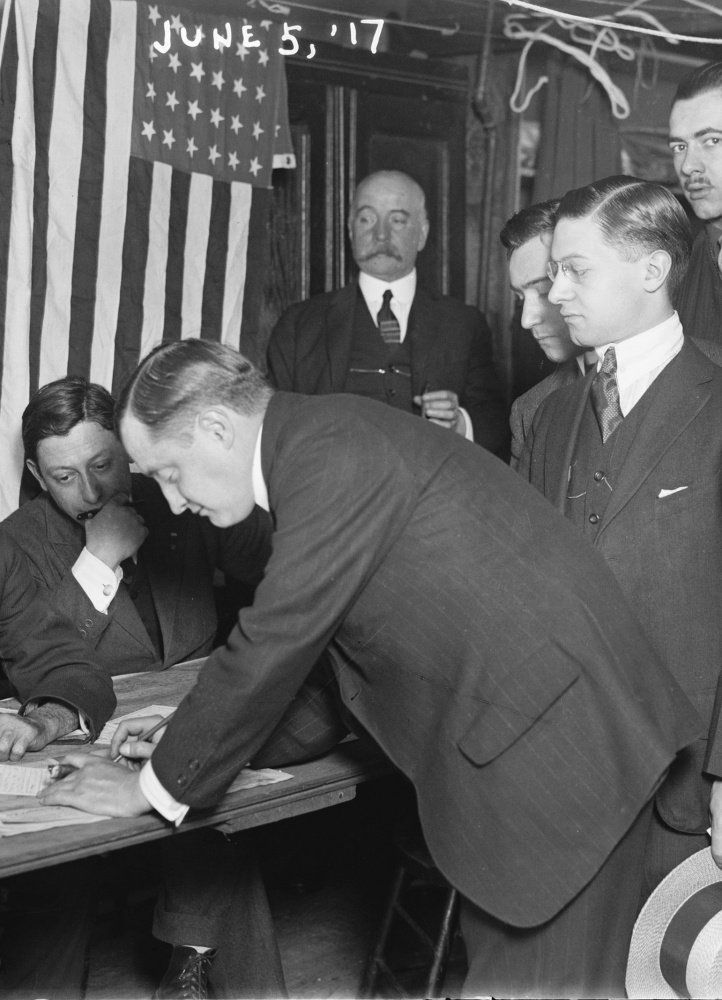Earlier this month, America commemorated the 73rd anniversary of D-Day, the Allied landings in Normandy that marked the beginning of the liberation of western Europe from Nazi domination.
Articles and broadcasts honoring the sacrifice of June 6, 1944, rarely mentioned that June 5, 1917, marked the centennial of another landmark in American military history. That day was registration day for American males aged 21 to 30, whom Congress had made subject to required service in the American armed forces that would soon be fighting in World War I against Germany and its allies.
Only two months before June 5, 1917, Congress had accepted President Woodrow Wilson’s request for a declaration of war against Germany. After vigorous debate, strong majorities in both the House and the Senate supported the president. Nonetheless, six senators and 50 members of the House voted against war with Germany.
Lawmakers on both sides recognized the momentous nature of the declaration. The horrors of war in Europe since August 1914 were well known to the members of Congress and to the American people. Numerous public statements from lawmakers emphasized that America had declared war against the strongest military power in the history of the world.
A TRADITION OF VOLUNTEER SERVICE
One of the first issues Congress faced after the declaration of war was how America would go from a small peacetime volunteer Army to a force that could influence the outcome of the world war. The American tradition had been to rely on volunteers to staff and expand its armies. The Revolutionary War volunteers at Lexington and Concord were the model American soldiers.
The one significant experience with required military service came in the Civil War. When necessity forced the Union Army to resort to conscription, draft riots broke out in New York City and elsewhere. Statutory provisions allowing the purchase of a substitute were widely criticized. The overall contribution of draftees to the Union victory was modest at best.
Nevertheless, in 1917 the professional leaders of the Army endorsed nationwide conscription to fill the American ranks. They persuaded President Wilson to support their cause and to ask Congress for legislation that would shape the Army around the military draft.
For the six weeks after the declaration of war, Congress engaged in one of the most significant debates in its history. Opponents of conscription raised a wide range of objections that challenged the constitutionality and wisdom of compelling military service. Concerns ranged from the disruption of race relations to the injustice of asking Americans of German ancestry to bear arms against their homeland.
STRONG MAJORITIES SUPPORTED DRAFT
Supporters of the draft stressed the efficiency of the draft and the fear that an army of volunteers only would bring the elite of American manhood into the military while leaving “slackers” to avoid service. Former President Theodore Roosevelt complicated the debate with his request to raise divisions of volunteers that would model Roosevelt’s Rough Riders from the Spanish-American War of 1898.
Eventually, strong majorities supported the Army bill and the draft. Those refusing service faced felony punishment. The bill also set a single day – June 5, 1917 – for a nationwide registration of all males from ages 21 to 30. That registration would begin a selection process of young men who would actually become soldiers.
The conscription or draft law on the statute books was one thing. The law in action was another. A June 3 New York Times headline, “More Anti-Draft Agitators in Jail,” reflected the considerable opposition to the draft from a variety of directions. Numerous registrants could contend that their elected representatives in Washington had voted against conscription as unconstitutional, unwise and a violation of American traditions.
What would happen if large numbers of required registrants simply refused to appear at the registration stations? Would the government be ready or able to bring tens of thousands of criminal prosecutions for draft evasion? Would civilian juries be ready to convict? Government officials must have faced June 5, 1917, with anxiety.
The news of June 6 could not have been better for President Wilson, the majority of Congress and the military. The Times headline “Probably 10,000,000 Enroll for War” captured the big picture. The Times reported that it found “no evidence of gloom, despondency or reluctance.” As one registrant put it: “It was the thing to do; everybody was doing it.”
An American Army had been shaped and a tradition of military conscription had been established that would allow America to fight its major wars of the 20th century.
Send questions/comments to the editors.



Success. Please wait for the page to reload. If the page does not reload within 5 seconds, please refresh the page.
Enter your email and password to access comments.
Hi, to comment on stories you must . This profile is in addition to your subscription and website login.
Already have a commenting profile? .
Invalid username/password.
Please check your email to confirm and complete your registration.
Only subscribers are eligible to post comments. Please subscribe or login first for digital access. Here’s why.
Use the form below to reset your password. When you've submitted your account email, we will send an email with a reset code.